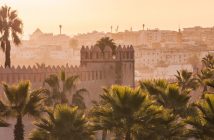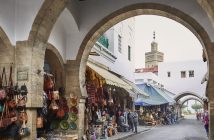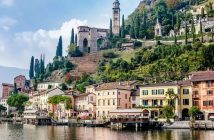Dear readers; I’ve never been out of Blighty for Christmas. Not for want of escaping the madness that assaults one from the beginning of October, that would be reason enough, more that I (and Mrs Larry, for that matter) have always felt duty-bound to return to the familial nest. But this year is different. The time had come to graduate from the reassuring warmth of a cosy fire and the oddities of party hats and cracker jokes so, with an announcement to our respective homesteads that we were going away this year, we’ve gone away this year. And we’ve opted for the polar opposite of Christendom’s Christmas. Well, ish. We’ve gone to Morocco.
Here is our plan; a weekend in Marrakech followed by a road trip of Gumball proportions, criss-crossing the Atlas Mountains from the Sahara to the sea.
We arrived on a Friday evening and were met at the airport by a driver from the Riad (B&B) we’d booked into. Bearing in mind I tend to be of a nervous disposition for the first 24 hours in an unfamiliar environment, particularly somewhere where I have no grasp of the language, this seemed sensible. However, alarm bells started ringing when we pull up nowhere near anything that looks like a hotel, rather we’re unceremoniously delivered to the gates of the old town and our bags removed from the boot into the arms of a waiting gentleman who scampers off with them through the gates of the Medina. This wasn’t part of the plan.
However, far from being the most blatant of theft scams imaginable, it transpires that since cars can’t get into the Medina (at least where we’re going) this chap’s a porter who, for a small tip, will take our belongings to our destination. Our driver instructs us to follow him which we duly do and we’re swept into the narrow alleys of the old town. It’s daunting the haste at which the porter whisks us through this warren and as I attempt to remember the right-left-right route we’re taking, and cursing my not bringing a ball of string, the sense of rising panic is heightened by the sinister-looking locals in their pointed djellabas and the shabby make-up of the Medina’s wattle and daub walls. There’s one saving grace that calms me as I surge towards my impending abduction: I notice other Western couples strolling, unphased, some even hand-in-hand as if this setting is somehow romantic. People deal with doom in so many ways.
Fortunately, our porter is not Riff Raff’s cousin and my heart rate returns to normal as I recognise a sign adorning a door as that of our Riad. We’re met by a permasmile doorman and ushered in and it’s tantamount to stepping into Narnia, the contrast couldn’t have been more acute from outside: it’s beautiful. Two levels of rooms, balconied round an atrium, centred by a fountain and adorned with palms and vines. Check-in seems infinitely more pleasant than the UK, too. Doubling as the concierge our doorman sits us down, offers mint tea and we’re asked to complete forms. Little is offered in the way of explanation of these, given the detail they require, but I’m told it’s a legal formality of registration. Registration for what, I wonder. My kidneys? Still, all seems perfectly innocuous, warmly welcoming in fact. Having waited an age for the tea – evidently its making involves a process that would put the Japanese through their paces – we waste no time admiring the simple facilities of our room (note to self: copper basin for the downstairs cloakroom back home) and, with the excitement of a new place coursing through us, we immediately set out for the famous Djemaa El Fna and dinner.
The mayhem of the square is exhilarating; the buzz about the famous lantern-lit food stalls, the cacophony of music played as horns and drums all compete with each other, the sheer volume and activity of people. Feeling brave but not yet courageous enough to tackle the offerings at the food stalls I do, however, feel compelled to adopt the ‘when in Rome’ mantra whenever I’m abroad and foremost on our minds for a meal is a traditional tagine.
Having consulted the guide book, we settle for what can politely be described as the minimalist Chez Chegroum to the north east corner of the square. Short shrift is made of the menu – there are only two offerings: tagine and couscous – so the decision is an easy one and I opt for the classic lamb and prune tagine. It’s uninspiring but I’m starving. I felt as if I’d inconvenienced the owner (and waiter, everyone multitasks here) every time I asked for something but, just like the tourist I’m pretending not to be, I find his offhanded nature entertaining. He, on the other hand, doesn’t quite reciprocate my English charm and doesn’t even flinch as I bumble through bank notes offering what I would consider to be a generous tip. I felt like asking for a tip back for being the only mugs to grace his restaurant but my Arabic hasn’t yet extended beyond “shokran”, so I thank him warmly and take my leave. Still, appetites succoured, if pride suckered, we set off across the square and down the lively Bab Agnaou. It feels like any provincial high street where the town’s youth congregate and peacock themselves. There’s little of note among the tourist shops so we head home and I’m struck by how cold it is without a jacket.
The next morning and Permasmile – evidently his duties extend to that of waiter too – greets us warmly as we descend to breakfast of sourbread with honey and tart coffee. Today begins power tourism in earnest and we plan a basic itinerary. Prior to coming, all advice pointed to simply getting oneself lost in the Medina and absorbing the atmosphere. This, however, is beyond me. We have two days in Marrakech and I’m determined to take in some of the sites. Fortunately, Marrakech’s historical places of interest extend to a couple of run-down palaces and makeshift museums so the former course may be our only option.
Stepping out into the Medina’s main drag it’s a complete contrast to the quiet, disconcerting alleys of the night before. They are now teaming with activity as every doorway reveals a souk and throngs of people crowd the narrow paths, all walking purposefully. How people know where they’re going is beyond me. Street signs are non-existent and maps are futile. Besides, it soon transpires that consulting a map or guidebook is the best way to open oneself up to harassment so, with a basic route memorised, I bag the book and we set off…and last about 30 seconds before the book’s out again. We’re heading for the rue (‘rue’ being a tenuous description at best) Zitou el Kedim and the Maison Tiskiwin, evidently hidden cunningly off the road in question to avoid being visited. Besides, ‘Maison’ in this instance is the operative word. It can’t so much be described as a museum, more that it feels as though we’re walking through someone’s unkempt house. Billed in the guide as a highlight, showcasing Berber and Bedouin artefacts, the décor is beautiful, admittedly – there’s definitely something charming and exotic about Moroccan design – but the artefacts are underwhelming helped in no way by the typed gibberish on the plastic-covered A4 sheet offered as a guide to the exhibits.
Finally into our stride any attempt to get into the Bahia Palace is thwarted by an insistent chap telling us to visit the Mellah, the Jewish Quarter. He leads us down a street, away from the near safety of a guided tour and proffers us towards a narrow alley under an archway in a wall. Not a chance. I’m sure his intentions were honourable, he even looked on the verge of tears at one point, such was his conviction that this was unmissable, but I wasn’t born yesterday.
We opt instead for exploring the ruins of the substantial Badii Palace, admiring the rooftop views of satellite dishes and stork nests from the terrace. Fortunately, as substantial as it is and glorious as I’m sure it once was, half an hour exposed to the sun and we were clamouring for the shadows of the Medina again. Nearing lunch, we decided on a route through the covered market – to get a sense of some of that atmosphere we’d been recommended – and atmosphere is what we get. It wasn’t so much a market as an abattoir and, as you can imagine, perfect for setting up our appetites for lunch.
The one advantage to lunch at the uncompromisingly touristy Café Argane at the top end of the Djemaa is a table on the balcony, if you can get one. The mediocre bowl of couscous from the ubiquitous tourist menu is slightly made up for by the views of the square and its snake-charmers and story-tellers. I’m particularly struck by one man holding court surrounded by a not insubstantial crowd of attentive listeners. It’s a wonderfully anachronistic tradition and is captivating even without any grasp of the language, such are the animations and tones used to relate their tales.
After lunch, having justified covering the best of the historical sites, we settle for getting lost in the Medina’s back streets but this stroll is abandoned twenty minutes in as we’re hustled out of 30 dirhams by a tannery worker offering us a tour of his workplace (that old chestnut) and then giving us directions we didn’t need. It was a little creepy in all honesty, he seemed to follow us from in front, engaged us in small talk and, in spite of my insistence that I knew where we were going, he had me pegged as a willing mug ready to part with cash simply for the pleasure of his conversation. Well, I was. I’m starting to wonder if I shouldn’t don a djellaba myself to avoid unnecessary harassment. Still, a detour into the souks proves far more rewarding; if the Djemaa is Trafalgar Square, here is Oxford Street and I note dozens of items for purchase that I don’t need: a lamp, a copper tray, a leather satchel, even a pouffe. Although the pouffe would be a must-have, surely.
Back at the riad, we weigh up the idea of a sauna from one of the public hammams (a real when in Rome experience, I’m told) but opt instead for another glass of Permasmile’s painstakingly-made mint tea and consider plans for the evening. It transpires there’s more to Marrakech than the Medina and, with the draw of a cold beer in mind, we’re off for a long walk down Mohammed V Avenue to the Hotel Nassim and the infamous Pub Anglais (or Chesterfield Bar). Now, I should stress this goes against all my travelling instincts – Rule #1 Avoid English/Irish ‘pubs’ at all costs – but were I to tell you that Mohammed V is far, far longer than we’d ever imagined (evidently the scale of the useless map in the guidebook suggested inches were inches) that beer became more than a simple diversion, it was a mission and a welcome relief from the stresses (yes, stresses – getting hassled relentlessly takes some getting used to) of the day.
Fortunately, our return journey back to the Medina takes a fraction of the time with a suicidal cab driver but dinner of merguez sausages among the Marrakshis at stand 31 in the Djemaa’s foodstalls is a highlight by a country mile. We’re wedged into a space on bench and a small bowl of harira slopped in front of us. There’s nothing really in the way of a menu and the sausages are served on a piece of paper (saves on the washing up) with warm, fresh bread. It’s divine. At last, we’d found the Rome we were looking for.





1 Comment
like to have jewish morrocan tagines recipe